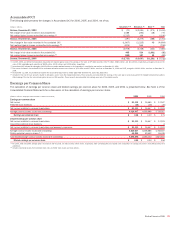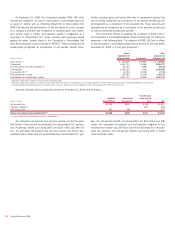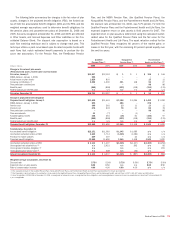Bank of America 2006 Annual Report Download - page 147
Download and view the complete annual report
Please find page 147 of the 2006 Bank of America annual report below. You can navigate through the pages in the report by either clicking on the pages listed below, or by using the keyword search tool below to find specific information within the annual report.
subsidiaries, provided certain criteria are met. Management elected to
apply the Act for 2005 and recorded a one-time tax benefit of $70 million
for the year ended December 31, 2005.
At December 31, 2006 and 2005, federal income taxes had not
been provided on $4.4 billion and $1.4 billion of undistributed earnings of
foreign subsidiaries, earned prior to 1987 and after 1997 that have been
reinvested for an indefinite period of time. If the earnings were distributed,
an additional $573 million and $249 million of tax expense, net of credits
for foreign taxes paid on such earnings and for the related foreign with-
holding taxes, would have resulted in 2006 and 2005.
Note 19 – Fair Value of Financial Instruments
SFAS No. 107, “Disclosures About Fair Value of Financial Instruments”
(SFAS 107), requires the disclosure of the estimated fair value of financial
instruments. The fair value of a financial instrument is the amount at
which the instrument could be exchanged in a current transaction between
willing parties, other than in a forced or liquidation sale. Quoted market
prices, if available, are utilized as estimates of the fair values of financial
instruments. Since no quoted market prices exist for certain of the Corpo-
ration’s financial instruments, the fair values of such instruments have
been derived based on management’s assumptions, the estimated
amount and timing of future cash flows and estimated discount rates. The
estimation methods for individual classifications of financial instruments
are described more fully below. Different assumptions could significantly
affect these estimates. Accordingly, the net realizable values could be
materially different from the estimates presented below. In addition, the
estimates are only indicative of the value of individual financial instru-
ments and should not be considered an indication of the fair value of the
combined Corporation.
The provisions of SFAS 107 do not require the disclosure of the fair
value of lease financing arrangements and nonfinancial instruments,
including Goodwill and Intangible Assets such as purchased credit card,
affinity, and trust relationships.
Short-term Financial Instruments
The carrying value of short-term financial instruments, including cash and
cash equivalents, time deposits placed, federal funds sold and purchased,
resale and repurchase agreements, commercial paper and other short-
term investments and borrowings, approximates the fair value of these
instruments. These financial instruments generally expose the Corporation
to limited credit risk and have no stated maturities or have short-term
maturities and carry interest rates that approximate market.
Financial Instruments Traded in the Secondary
Market and Strategic Investments
Held-to-maturity securities, AFS debt and marketable equity securities,
trading account instruments, long-term debt traded actively in the secon-
dary market and strategic investments have been valued using quoted
market prices. The fair values of trading account instruments, securities
and strategic investments are reported in Notes 3 and 5 of the Con-
solidated Financial Statements.
Derivative Financial Instruments
All derivatives are recognized on the Consolidated Balance Sheet at fair
value, net of cash collateral held and taking into consideration the effects
of legally enforceable master netting agreements that allow the Corpo-
ration to settle positive and negative positions with the same counterparty
on a net basis. For exchange-traded contracts, fair value is based on
quoted market prices. For non-exchange traded contracts, fair value is
based on dealer quotes, pricing models or quoted prices for instruments
with similar characteristics. The fair value of the Corporation’s derivative
assets and liabilities is presented in Note 4 of the Consolidated Financial
Statements.
Loans
Fair values were estimated for groups of similar loans based upon type of
loan and maturity. The fair value of loans was determined by discounting
estimated cash flows using interest rates approximating the Corporation’s
current origination rates for similar loans and adjusted to reflect the
inherent credit risk. Where quoted market prices were available, primarily
for certain residential mortgage loans and commercial loans, such market
prices were utilized as estimates for fair values.
Substantially all of the foreign loans reprice within relatively short
timeframes. Accordingly, for foreign loans, the net carrying values were
assumed to approximate their fair values.
Deposits
The fair value for deposits with stated maturities was calculated by dis-
counting contractual cash flows using current market rates for instruments
with similar maturities. The carrying value of foreign time deposits approx-
imates fair value. For deposits with no stated maturities, the carrying
amount was considered to approximate fair value and does not take into
account the significant value of the cost advantage and stability of the
Corporation’s long-term relationships with depositors.
The book and fair values of certain financial instruments at
December 31, 2006 and 2005 were as follows:
December 31
2006 2005
(Dollars in millions) Book Value Fair Value Book Value Fair Value
Financial assets
Loans
(1)
$675,544 $679,738
$545,238 $542,626
Financial liabilities
Deposits
693,497 693,041
634,670 633,928
Long-term debt
146,000 148,120
100,848 101,446
(1) Presented net of the Allowance for Loan and Lease Losses.
Note 20 – Business Segment Information
The Corporation reports the results of its operations through three busi-
ness segments: Global Consumer and Small Business Banking, Global
Corporate and Investment Banking, and Global Wealth and Investment
Management. The Corporation may periodically reclassify business seg-
ment results based on modifications to its management reporting method-
ologies and changes in organizational alignment.
Global Consumer and Small Business Banking provides a diversified
range of products and services to individuals and small businesses
through its primary businesses: Deposits, Card Services, Mortgage and
Home Equity. Global Corporate and Investment Banking serves domestic
and international issuer and investor clients, providing financial services,
specialized industry expertise and local delivery through its primary busi-
nesses: Business Lending, Capital Markets and Advisory Services, and
Treasury Services. These businesses provide traditional bank deposit and
loan products to large corporations and institutional clients, capital-raising
solutions, advisory services, derivatives capabilities, equity and debt sales
and trading for clients, as well as treasury management and payment serv-
ices. Global Wealth and Investment Management offers investment serv-
ices, estate management, financial planning services, fiduciary
management, credit and banking expertise, and diversified asset
management products to institutional clients, as well as affluent and high-
net-worth individuals through its primary businesses: The Private Bank,
Columbia Management and Premier Banking and Investments.
Bank of America 2006
145






















